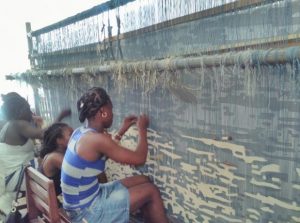Quite big. I had some of the women there at the end of the month of teaching them in June 2016 that came to me and said: “you gave me a future, you gave me an opportunity to earn money for my children so that I can send them to college”. That is something quite impressive, and it was the goal, to implement a new industry here because weaving had been forgotten and we wanted to implement it again. Therefore, after the curtain is finished, I am currently working on a second project, a follow up to keep the weaving alive so that I am not needed any more, but it is done here. The goal is to have the design done on the island as well as the weaving. So to achieve a new industry in that sense. Quite big. I had some of the women there at the end of the month of teaching them in June 2016 that came to me and said: “you gave me a future, you gave me an opportunity to earn money for my children so that I can send them to college”. That is something quite impressive, and it was the goal, to implement a new industry here because weaving had been forgotten and we wanted to implement it again. Therefore, after the curtain is finished, I am currently working on a second project, a follow up to keep the weaving alive so that I am not needed any more, but it is done here. The goal is to have the design done on the island as well as the weaving. So to achieve a new industry in that sense.
For three years, it was good for the weavers to have a safe income and to learn a new technique. Now that it is finished, if they don´t have new orders, then it will be a disappointment.
Then, it will stop. That is the reason that I am currently working together with the Art School Atelier M at Kwame Sousa. I am currently collaborating with them and their students on how to teach them how to design textile. The students can make the design so that then, afterwards, the weavers can weave it. I was here last February to give lectures about concept design and textile design at the Art School of Kwame Sousa. We had discussions and conversations about cultural heritage because the current cultural heritage of São Tomé and Príncipe is always the Tchiloli. Then you have got the national costume which is of Portuguese origin. So, I was more looking to what is the common cultural heritage and, of course, I am a designer from the Netherlands and cannot tell them, “so, this is your cultural heritage”. That is not my position. But, I can help them, steer them towards it, with design thinking tools. So, the aim goal is, for me to be out of the system and have it working by itself.
We are working with some family stories that are told from generation to generation and students are now working on visualizing those stories and then afterword we will translate it into textile design. I spoke with Kwame last week. And currently, they are doing this Rhinoceros artwork, and after that, they are going to do big paintings, so I expect that by the end of this summer they will have some visuals.



